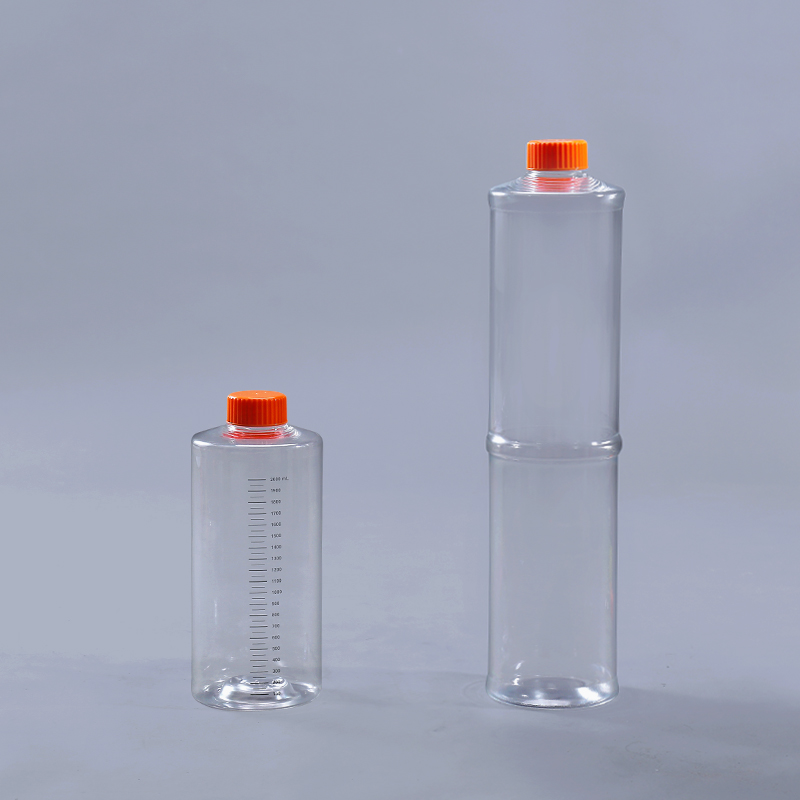ตามชื่อคือประเภทของวัสดุสิ้นเปลืองที่ใช้ในการเพาะเลี้ยงเซลล์ ด้วยความช่วยเหลือของระบบขวดลูกกลิ้งเพาะเลี้ยงเซลล์ มันถูกใช้กันอย่างแพร่หลายในด้านชีววิทยาของเซลล์ ไวรัสวิทยา จุลชีววิทยา และอุตสาหกรรมยาการเพาะเลี้ยงเซลล์และเนื้อเยื่อในหลอดทดลองได้กลายเป็นสิ่งที่ขาดไม่ได้ เนื้อหาในสาขาวิทยาศาสตร์เพื่อชีวิต เซลล์ที่เพาะเลี้ยงมีหลายประเภท ตั้งแต่ไวรัส แบคทีเรีย ไปจนถึงเชื้อรา ตั้งแต่เซลล์ของมนุษย์ไปจนถึงเซลล์สัตว์และเซลล์พืช เซลล์และเนื้อเยื่อบางชนิดสามารถเจริญเติบโตได้ในแบบแขวนลอย แต่เซลล์ของสัตว์เลี้ยงลูกด้วยนมจำนวนมากจำเป็นต้องยึดติดกับพื้นผิว ดังนั้นข้อกำหนดสำหรับวัสดุสิ้นเปลืองในการเพาะเลี้ยงเซลล์จึงค่อนข้างสูงขวดลูกกลิ้งเซลล์
ขวดลูกกลิ้งเซลล์เหมาะสำหรับการเพาะพันธุ์ที่หลากหลาย ของเซลล์ยึดเกาะและเซลล์แขวนลอย เช่น เซลล์ Vero, เซลล์ HEK 293, เซลล์ CAR-T, MRC5, เซลล์ CEF, มาโครฟาจถุงสุกร, เซลล์มัยอีโลมา, เซลล์ DF-1, เซลล์ ST, เซลล์ PK15, เซลล์ Marc145 และเซลล์ยึดติดอื่นๆ ; เซลล์แขวนลอย เช่น เซลล์ CHO เซลล์แมลง เซลล์ BHK21 และเซลล์ MDCK
วัสดุสิ้นเปลืองสำหรับการเพาะเลี้ยงเซลล์มีหลายประเภท ขวดลูกกลิ้งเซลล์เป็นเพียงหนึ่งในนั้น ขวดเขย่าที่มีประสิทธิภาพสูง โรงงานเซลล์ แผ่นเพาะเลี้ยงเซลล์ จานเพาะเชื้อแบคทีเรีย ฯลฯ ล้วนเป็นวัสดุสิ้นเปลืองของเซลล์ วัสดุสิ้นเปลืองแต่ละอย่างขึ้นอยู่กับข้อกำหนดการใช้งานและวิธีการเพาะเลี้ยงเซลล์ สอดคล้องกับข้อกำหนดและวัสดุที่แตกต่างกัน เป็นรายการที่จำเป็นในกระบวนการเพาะเลี้ยงเซลล์
There are various types of consumables for cell culture. Cell roller bottles are just one of them. High-efficiency shake flasks, cell factories, cell culture plates, bacterial culture dishes, etc. are all cell consumables. Each consumable is based on usage requirements and cell culture methods. Corresponding to different specifications and materials, it is an essential item in the cell culture process.
The FAI climbed 5.9 percent year-on-year in the first 11 months of 2018, quickening from the 5.7-percent growth in Jan-Oct, the National Bureau of Statistics (NBS) said Friday in an online statement.
The key indicator of investment, dubbed a major growth driver, hit the bottom in August and has since started to rebound steadily.
In the face of emerging economic challenges home and abroad, China has stepped up efforts to stabilize investment, in particular rolling out measures to motivate private investors and channel funds into infrastructure.
Friday's data showed private investment, accounting for more than 60 percent of the total FAI, expanded by a brisk 8.7 percent.
NBS spokesperson Mao Shengyong said funds into weak economic links registered rapid increases as investment in environmental protection and agriculture jumped 42 percent and 12.5 percent respectively, much faster than the average.
In breakdown, investment in high-tech and equipment manufacturing remained vigorous with 16.1-percent and 11.6-percent increases respectively in the first 11 months. Infrastructure investment gained 3.7 percent, staying flat. Investment in property development rose 9.7 percent, also unchanged.
 English
English



















































